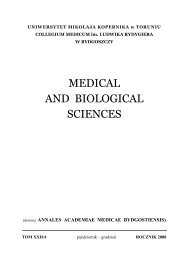Medical and Biological Sciences XXVI/2 - Collegium Medicum ...
Medical and Biological Sciences XXVI/2 - Collegium Medicum ...
Medical and Biological Sciences XXVI/2 - Collegium Medicum ...
Create successful ePaper yourself
Turn your PDF publications into a flip-book with our unique Google optimized e-Paper software.
Intrarater repeatability of manual testing of first muscle movement resistance 27<br />
participants had increased muscle tension, i.e.<br />
functional problem, rather than structural contraction.<br />
METHOD<br />
The test was conducted using three-dimensional<br />
movement measuring system based on active<br />
ultrasound markers, ZEBRIS, manufactured in<br />
Germany by ZEBRIS <strong>Medical</strong> GmbH. In that case<br />
system consists of ZEBRIS CMS-HS main unit,<br />
measuring unit (MU), <strong>and</strong> set of four single ultrasound<br />
markers (transmitter).<br />
The main unit collects the signal from the<br />
measurement unit <strong>and</strong> provides control <strong>and</strong><br />
coordination between single ultrasound markers,<br />
initializing signal sent by them. Main unit collects <strong>and</strong><br />
initially processes acquired data in real time<br />
measurement.<br />
The measuring unit consists of three single<br />
receivers (microphones), fixed on a solid frame in<br />
established position to each other. Each microphone<br />
calculates simultaneously distance from the ultrasound<br />
marker or markers. This allows, when using<br />
triangulation rules, to define coordinates of each<br />
transmitter in three dimensional coordinate system<br />
referred to measuring unit. Calibration allows<br />
determining the MU towards the frontal, sagittal <strong>and</strong><br />
transversal plane [15].<br />
Single ultrasound markers are small transmitters,<br />
which could be placed on patients’ skin using adhesive<br />
tape or Velcro strips. The frequency of signal emitting<br />
is set in software used <strong>and</strong> can be changed depending<br />
on measurement requirements <strong>and</strong> equipment<br />
capabilities. Placement of transmitters can be dictated<br />
by a software <strong>and</strong> protocol used, or freely chosen by<br />
user. The precision of marker localization in optimal<br />
condition can be very high, <strong>and</strong> reaches values below<br />
0.14 mm for linear <strong>and</strong> 0.16 degrees for angular<br />
movement [16].<br />
In this study WinData (ZEBRIS <strong>Medical</strong> GmbH,<br />
Germany) software were used. This software has no<br />
rigid protocols of measurement, <strong>and</strong> provides<br />
possibility of construction complete <strong>and</strong> individual<br />
measurement protocols which fits best to the specific<br />
requirements of a particular study [17].<br />
In order to assess manual testing of triceps surae<br />
(TS) first mechanical resistance repeatability, authors<br />
measured angular position of the ankle <strong>and</strong> calf muscle<br />
length at the moment when the therapist felt that<br />
resistance. To achieve this, the single markers were<br />
placed on:<br />
• Lateral femoral condyle<br />
• Posterior part of calcaneal tuberosity at the<br />
attachment of the Achilles tendon<br />
• Above lateral ankle, at the axis of<br />
flexion/extension movement<br />
• Lateral side of 5-th metatarsal bone base<br />
Based on this markers placement, following<br />
parameters were calculated:<br />
1. Ankle flexion, described as Angle between<br />
vector of the fibula, connecting marker on lateral<br />
femoral condyle <strong>and</strong> lateral ankle, <strong>and</strong> line built of<br />
markers on lateral ankle <strong>and</strong> 5-th metatarsal bone.<br />
2. Length of the Triceps Surae muscle, <strong>and</strong><br />
actual length of lateral head of gastrocnemius<br />
muscle. That was calculated as a distance between<br />
a marker placed on insertion <strong>and</strong> origin of that<br />
muscle, i.e. on lateral femoral condyle <strong>and</strong> on<br />
calcaneal tuberosity.<br />
The frequency of signal transmission for each<br />
marker was 20 Hz.<br />
The test was executed by a skilled <strong>and</strong> experienced<br />
in manual therapy therapist. Patient was lying supine<br />
on a couch, in comfortable position, with both legs<br />
extended. After placing markers on the right positions,<br />
the therapist asked the patient to relax <strong>and</strong> try not to<br />
make any movement. Then the therapist made three<br />
attempts to flex patient’s ankle to dorsal flexion till he<br />
felt first mechanical resistance of stretched Triceps<br />
Surae muscle. The therapist was asked to stop for<br />
about two three to five seconds after reaching this<br />
‘destination point’. Spatial position of all four markers<br />
was recorded from the beginning to the end of the test.<br />
The knee of the patient was still fixed in extension. The<br />
therapist performing manual testing was not allowed to<br />
see the monitor screen with graphical exposition of<br />
measured angular parameters till the test was over.<br />
Obtained data were then analyzed using st<strong>and</strong>ard<br />
statistical tools, such as mean, st<strong>and</strong>ard deviation,<br />
relative values <strong>and</strong> st<strong>and</strong>ard error of mean in<br />
Microsoft Office software.<br />
RESULTS<br />
For every test there were three values of angular<br />
position of foot <strong>and</strong> lower limb collected, each of every<br />
trial. Based on these results, St<strong>and</strong>ard Deviation

















